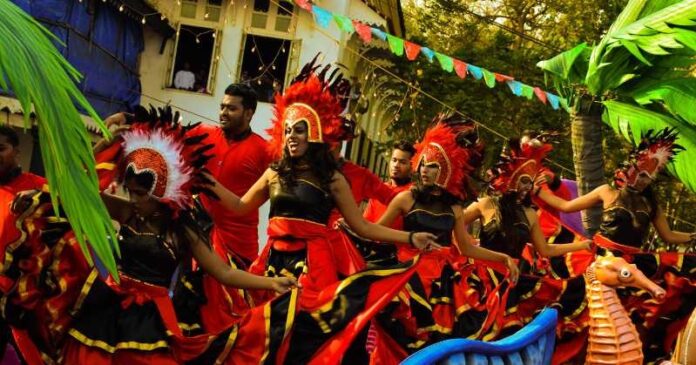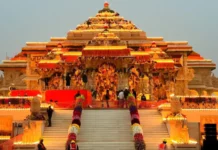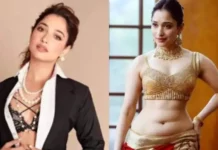Goa’s traditional folk dance is deeply rooted in traditions, customs, and culture, and it reflects the state’s long history, social strata, and glimpses of Goan life. The cultural roots of Goa’s traditional dances will transport you back in time, with influences from rulers, cultures, and faiths. Some of the most well-known traditional Goan folk dances are Ghode Modni, Dhangar Dance, Goff Talgadi, Shigmo, and Mussel Khel.
Here are some of the famous Goan Dances.
1. Ghode Modini
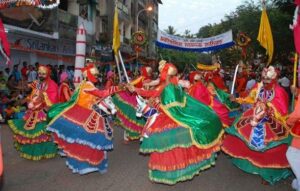
It is one of the most well-known folk dances in Goa. The experience of watching this dance form transports you to the world of ancient warriors. In the background music of Dhol, the dancers swing around, tucking dummy horses around their waists and wielding swords as a symbol of bravery. A wooden horse is used as a prop. Horses are dressed in bright colors and have vivid flowers on their hair. Dancers also wear ghungroo on their ankles and colorful costumes (Rajput garments) and Pagdi, which Marathas used to wear. A wooden mask is also worn by dancers. This mask is considered holy, and members only remove it when they must dance.
2. Dhangar Dance
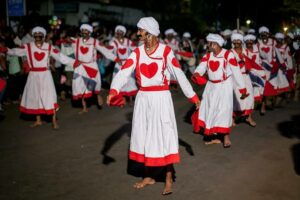
It’s a Goan religious folk dance done by the Dhangar shepherds to appease their folk god Bhira Deva. To the beat of Dhol, dancers in Kathiawari’s white robes and turbans with colorful handkerchiefs walk around. During the Hindu festival of Navratri, when people worship their local deities, this dance is commonly performed.
The Dhangar dance, commonly known as a Navaratri dance, combines charming elements. The head of the home fasts on Navratri wakes up early in the morning and takes a bath, and if he is a father, he drinks a cup of milk every day and prays with his family. The dance begins slowly, with simple footwork, to the beat of a drum. Drum’s swirl around the drummer/drummer when dancing.
3. Lamp Dance
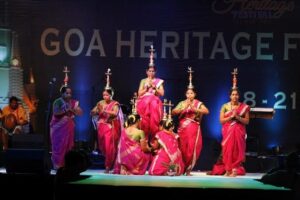
During the Shigmo Festival, the lamp dance is commonly done. Dancers wear brass lamps on their heads and move their bodies without causing the lamps to move. This dance is made even more beautiful by the use of a variety of musical instruments such as cymbals, ghumats, harmoniums, and samels. The dance is one of the very famous dances of Goa. Because of the brass lamps, the Lamp Dance is called that.
To balance the lamps, the dancers must engage in slow dance moves, which are accomplished with delicate footwork and enormous self-discipline. The dancers follow the beats of classic folk melodies, and the entire performance is captivating. Instrumental music and traditional instruments such as the Ghumat, Samael, Cymbal, and Harmonium are commonly used in the Lamp dance. In central and southern Goa, the dance is very popular.
4. Dashavatara
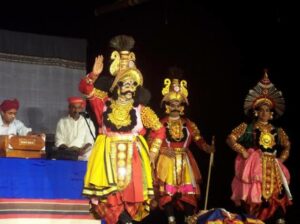
The name of the dance form comes from Lord Vishnu’s 10 incarnations. This dance, which originated in Kerala, was introduced to the Konkan region in the 16th century. Dashavatara actors are distinguished from the audience by their red and white makeup. The dance begins with the ‘Sutradhar,’ a stage manager, offering devotion to Lord Ganpati. He also speaks loudly and with screamed words about the robbery of the ‘Vedas.’ As the drama progresses, ‘Brahmin’ figures, women performers depicting rivers, players portraying Lord Brahma (the Creator) and Goddess Saraswati (the goddess of learning), and the demon Shankhasur arrive.
5. Dekhni
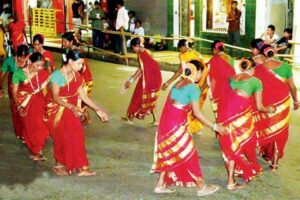
In Konkani, it implies enchanting beauty. The iconic filmmaker Raj Kapoor transformed a classic Dekhni song, ‘Hanv Saiba Poltodi Vetam,’ into ‘Na mangoon Sona Chandi’ for his film Bobby. A group of girls performs the Dekhni Dance while holding earthen oil lamps. Bharatnatyam and Kathak have adopted several Dekni motions. It’s also known as a semi-classical folk dance because of this. In this dancing form, the girls are depicted as God’s servants. It portrays a devadasi’s life. On request, Devadasis used to perform in temples and on happy occasions.
6. Fugdi
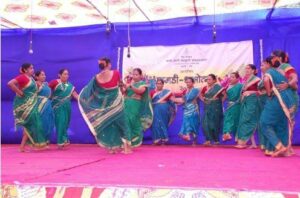
The months of August and September are brightened by this folk dance. The dance gets its name from the joyful ‘Foo’ sound generated when the dancers follow the pace by blowing air through their mouths. A Kalshi, or water pitcher, is the major prop in this dance. It has a unique value in the life of rural women since they use it every day for all of their tasks. Their everyday activity consists of fetching water, cooking, cleaning, and watering plants with it.
The dance begins with the women lighting a Diya in front of the Tulsi plant. They pray to the gods to bless the location. Women sing about deities gifting them with sarees, jewelry, flowers, and bangles in the songs used in Fugdi dance. They are also granted a blissful reunion with their spouses by the gods. The dance is one of the very famous dances in Goa.
7. Dhalo

On a moonlight December night, women perform Dhalo, which is one of Goa’s most popular rural dances. After dinner, a dozen ladies gather in a house’s courtyard to dance to traditional tunes with religious and social themes. The performance begins with the group’s chief woman honoring Mother Earth and requesting her to bless their dance and festival ceremonies. She prays to Mother Nature to protect their hamlet from danger and to ensure that the event goes off without a hitch.
The performance has twelve to fourteen women. They dance in two rows, their hands clasped. During the dancing performance, the women bow down together with interlaced hands. The dancers’ motions are calm and graceful, yet they also convey the excitement with which they dance. After the other row, each row bows down. As part of the ceremony, women draw men’s sketches at the end of the dance.
8. Goff

Each dancer holds a colorful rope hanging at the center of the mand— the performance space— making an elaborate braid with the rest of the performers as a celebration of a bountiful harvest. The dancers reverse their positions in the second half of the performance, the music starts up again, and the dancers invert the rhythm of dancing in such a way that the braid is revealed at the end of the second movement, and all the cords are loose and single once more.
9. Musalam Khel

A combat dance commemorating the victory of King Harihara II of the Vijaynagar empire over the Cholas. As the Cholas’ bear captor, the actors are led by a senior Kshatriya gaunkar (villager) dressed in a well-worn black blanket and clutching a fig branch. Chandor’s Christians maintain a tradition alive by performing this type of dance every year. Their Yadavas-style clothes are appropriate for the event. Dancers with flaming torches accompany the Shivlinga sign, which is hoisted and waved throughout the dance.
10. Kunbi
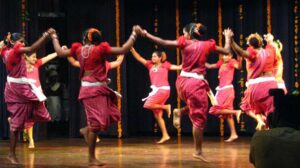
Kunbi, Goa’s first inhabitants, is a strong tribal population that predominantly lives in the Salcete taluka. Their pre-Portuguese era music and dances are social rather than religious. Women execute this dance in a group and move quickly while also moving beautifully. The steps are well-plotted, and the coordination is outstanding. Because there are no religious songs or actions in the dance, it can be inferred that it was solely for enjoyment. This dance is only performed by women, while males play instruments in the background.
11. Veerbhadra
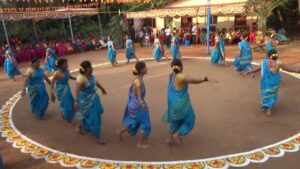
This folk dance is a tribute to Veerbhadra, a Hindu God Shiva’s attendant who is commonly recognized as Shiva’s son. An artist dressed in royal garb flashes two swords in his hand as if prepared for a war to the rhythms of the dhol (drum) and Casale (cymbals). During the dance, phrases such as tha-thai-ya, thak-thai-ya are used to mark the beat in a very southern style. Veerbhadra is a religious celebration that takes place once a year in some sections of the Ponda district and Sanguem. Veerbhadra, on the other hand, is only performed in Sanquelim.
12. Corredinho
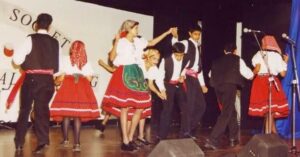
This dance, which originated in the Algarve region of Portugal and comprises six partners and some superb footwork, is another example of Portuguese influence on Goan culture. The corridinho is a type of folk dance popular in the Algarve region of Portugal. The dance’s origins are unknown, but it is thought to be older, as it acquired popularity in the 1800s. The word correr, which means “to run,” is used to characterize this form of dancing. In the open air, the dance was performed in a circle.

